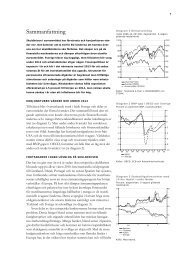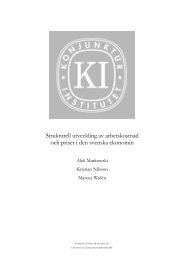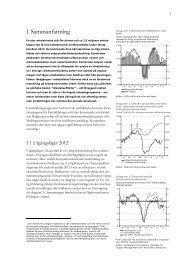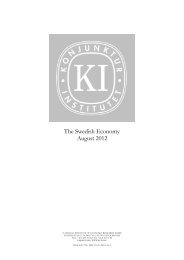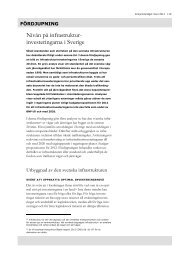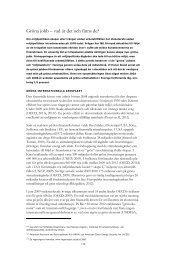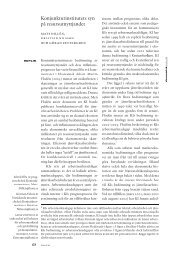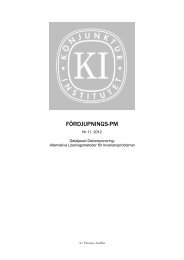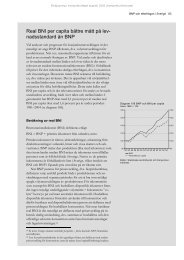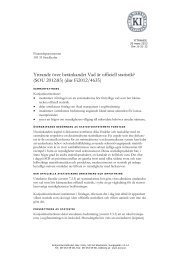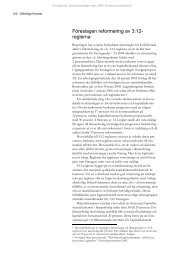Central Bank Forecasts of Policy Interest Rates - Konjunkturinstitutet
Central Bank Forecasts of Policy Interest Rates - Konjunkturinstitutet
Central Bank Forecasts of Policy Interest Rates - Konjunkturinstitutet
You also want an ePaper? Increase the reach of your titles
YUMPU automatically turns print PDFs into web optimized ePapers that Google loves.
14Both Norges <strong>Bank</strong> and the Riksbank do reasonably well relative to a naïve forecast. Norges <strong>Bank</strong>outperforms it at all horizons, as does the Riksbank at the three-month and one-year horizons.That is, central banks add information above and beyond a naïve forecast at reasonably long horizons,calling into question Goodhart and Lim’s (2011) suggestion that central banks should adopt amore mechanical approach – such as a no-change or implied forward market rate assumption – athorizons beyond two quarters. 9Goodhart and Lim’s (2011) recommendation can also be questioned on other grounds. Both a constantpolicy interest rate over the forecast horizon and implied forward market rates have been usedand later abandoned by several central banks (including Norges <strong>Bank</strong> and Sveriges Riksbank);drawbacks included difficulties in generating and interpreting the forecasts and indeterminacy inforecasting scenarios. 10 There is also intuitive theoretical appeal in the idea that communicating theoutlook aids private agents’ decision making about consumption and investment – thereby improvingthe implementation <strong>of</strong> monetary policy. Publishing endogenous interest-rate forecasts is also inline with the conclusions <strong>of</strong> Faust and Leeper (2005) and Faust and Wright (2008) that unconditionalforecasts <strong>of</strong> the policy interest rate (and goal variables) provide a more effective means <strong>of</strong>communication than conditional forecasts.4. ConclusionsThe results in this paper reveal only modest differences in forecast precision between central banks’policy-rate projections and market-implied rate expectations. From a policy point <strong>of</strong> view, this isinteresting for a number <strong>of</strong> reasons. First, it is probably comforting for proponents <strong>of</strong> endogenousinterest-rate path publications that the central bank’s forecast precision is roughly on par with themarket’s and generally superior to a naïve forecast. From that benchmark, concerns that publication<strong>of</strong> central-bank projections may prompt a deterioration in other agents’ forecasts seems unwarranted.11 Second, the relatively even forecast performance – combined with the fact that the centralbanks do fairly well compared to a naïve forecast – does not lend support for Goodhart and Lim’s(2011) recommendation that central banks should abandon their own forecasts in favour <strong>of</strong> marketimpliedexpectations or no-change forecasts. Third, when divergences do arise between the centralbank and the market-implied forecasts, the results in this paper do not give strong priors about howthe divergence will be resolved. After all, market-implied expectations have, over these samples,been as fair a guide to future developments as central-bank forecasts.9 Specifically, Goodhart and Lim (2011) evalutate short-term interest rate forecasts in New Zealand and the UnitedKingdom where the former are the forecasts <strong>of</strong> the Reserve <strong>Bank</strong> <strong>of</strong> New Zealand and the latter have been derived frommoney market yield curves. They conclude (p. 135) that the forecasts ”… have been excellent for the immediateforthcoming quarter, reasonable for the next quarter, and useless thereafter”.10 See, for example, Ólafsson (2007) for a discussion.11 Dale et al. (2011) suggest that a central bank which publishes forecasts <strong>of</strong> poor quality risks causing the privatesector’s forecast precision to deteriorate.



